Transcript
Hi I’m Peter Richman and I’m from Plug & Play, and for the last 18 years we’ve been helping improve our clients’ market penetrations, increase their engagement levels on their websites and convert more visitors on their website into enquiries and ultimately new customers.
Today I’m going to be talking about classical marketing principles and how these can be used to help you attract and convert the right clients and candidates.
Creating resonance
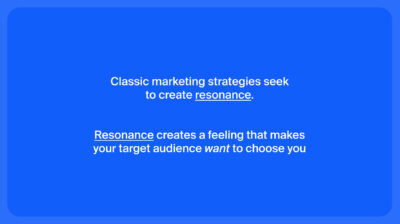
Now for me, creating resonance is really similar to how we try and find the right people. As recruiters, you’ve probably been in a situation where you’ve been trying to find the right candidate for your client and different CVs might be crossing your desk and they’re just not the right people, and they don’t have the right skills, background or fit that you’re looking for within the business.
And then the right CV comes along and you know almost instantly that they’re going to be good because the CV reads really well, they’ve got the right skills and they’ve got the right background. So you give them a call and they’re really good on the phone and you can see how there would be a really good cultural fit with the business so you get them in for an interview. That excitement and feeling that you’re getting from that alignment of knowing they’ve got the right skills and the right background and the right fit for the right role. That alignment creates this resonance. It creates this feeling within us. You can tell that this candidate is the right candidate for the right client.
Creating resonance in our marketing
And this is what we’re trying to create in our marketing. We want our marketing to create resonance with our target audience on a Thursday evening at 10 o’clock at night when you’re not there to present the business in person. Your website, your marketing, your LinkedIn posts, all of your brand and everything else needs to create that resonance within your clients and make them want to choose you. So really when we’re thinking about classical marketing principles what we’re really talk about is resonance.
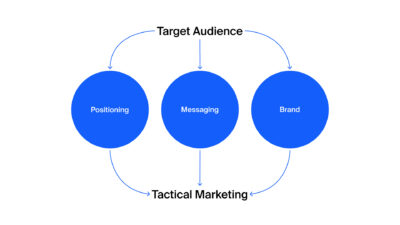
So how do we create resonance? How are we going to make that happen? To do this we need to take a look at your target audience and understand them at a deeper level. We’re going to be thinking about how we can to position ourselves to reflect that target audience and the key messages we can deliver to help create that resonance in written form.
Outside of written form we need to think about the brand. We need to think about how the look and feel of your brand is going to make people feel a certain thing without them having to be specifically told, and how those can all be brought together in your tactical marketing – whether it’s your website, your outbound, your LinkedIn or any of your social posts, or anything that you’re doing offline. How do we help make marketing happen?
Because at the end of the day getting stuff out the door is so much harder than anything else. When you come up with an idea and say ‘yeah we can do this in marketing’, the next steps are to actually do the design, figure out how’s it going to come together and what we’re going to say. Getting this homework done in terms of positioning, messaging and brand is going to help you get that marketing done.
Target Audiences
Target audience is really specific to two key things – we’re looking at the business and we’re looking at the person. And coming back to that analogy that I was using about trying to hire and find the right person. What we’re really looking at is the attributes of your target businesses and the people that work there. We want your target audience to see themselves within your marketing both in terms of written messaging and in terms of brand.
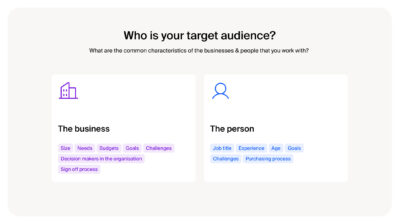
Creating that reflection starts off by understanding the attributes of your target audience. These attributes can be size, needs, budget, number of hires, seniority of hires or the types of hires, the vertical by sector or sub-sector, amongst many other possible factors. What we need to do is think about how we can lean into the right attributes to help create a market position where we can excel and we can own a niche where we can generate more new leads by reflecting the needs of those customers and for them to feel resonance within our marketing.
Download your battle card templates to complete for your target businesses and people.
The business
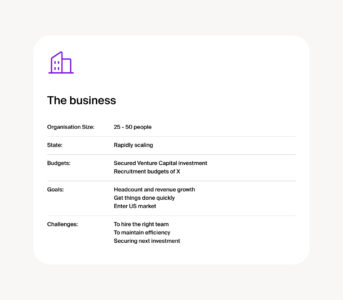
We can think about the different attributes of the businesses that are well aligned with us including size, state, the budgets, the goals and so on. They could be very specific to a sector or the type of hires they outsource – maybe they’re hiring graduates or senior managers.
The person
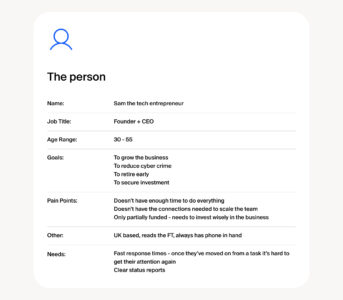
We should also understand the people that we work with within these target businesses. Do you mostly work with HR Managers, Operations or Directors? Who are the decision makers and budget holders that you need sign off from to close a new client?
Businesses in recruitment do really well because people buy from people and this is even more pronounced in the recruitment industry. So we need to plan how we are going to reflect these individuals within our marketing. Recruiters do this extremely well in person and are skilled at creating a rapport and vibe. The next step is to capture that and translate it into your marketing. Doing this is about understanding the target individuals and what they need to see and hear from you to feel that you are the right recruitment business for them. So again looking at what is it what’s the determining factor about these people that actually means that you get on really well with them and that you’re actually able to market to them really effectively offline and in person and how can we recreate that online.
Download battle card templates
Why do clients and candidates choose you?
So why do clients and candidates choose you? There’s loads of things to consider here and there’s going to be some factors that you’re in control of and there could be others that are just facets of the business. For example location, reputation, sector, sub sector, people you’ve hired before, your track record and your client list are all things that are going to enable you to attract candidates and clients. So of course if you’ve got a good track record of hiring for particular businesses, you’ll likely to get more and better candidates and therefore more and better clients.
So we need to combine our knowledge of our target clients and the things that we’re good at, or the reasons clients and candidates choose us, to create our niche in the market that enables us to effectively represent ourselves and create resonance.

Market position
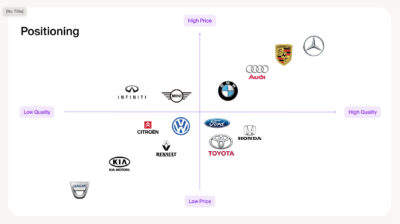
Above is a classic positioning marketplace chart that shows a quadrant that maps pricing against quality for car brands. This example shows cars but these quadrants can be used for any market. As you can see, there’s a positive correlation between price and quality. These car brands will have gone through a positioning exercise to decide which part of the market they want to target so they know how to appeal and speak to their audience. Then as consumers, we choose our car brands based on their position in the market. For example, do we want premium quality for a premium price? Do we want an expensive car that is style over substance? Or are we looking for a mid price point for a reliable but simple car?
What you might find useful as a bit of homework is to draw out a number of different quadrants for your business. Maybe you have a quadrant where you plot the seniority of the job roles your hire for or the number of roles that need to be placed. Perhaps you have 1 quadrant for the Pharma sector and another for the Tech sector. The goal here is to take a number of different attributes of your business and plot yourself against your competitors. By doing this, you’re able to start thinking okay well actually we’re really decent within this space within those parameters within those attributes and you can start carving out a niche. What’s interesting is that once you understand how you’ve carved that niche, you’re able to articulate it much more effectively. So we’re going to take this niche and our understanding of this niche and these attributes and how we’re going to play them back to our customers. This is because reflecting your audience within your marketing is what’s going to create that resonance.
So creating that resonance and reflecting back to our audience can be done in a number of different ways within our messaging. For example an elevator pitch may look like:
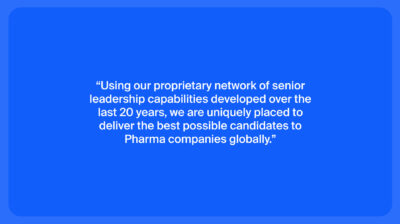
This statement actually has a number of different attributes to it. We know they work with Pharma companies, they’re global, and they have a network of senior leadership. So there’s three attributes there that are a reflection of an example target audience.
So we should think about how we can get three or more attributes within our messaging because when that client or candidate visits our website or sees our marketing, they’ll see themselves reflected back in that content. They’re going to feel that resonance and think ‘wow they specifically work with people just like me’.
Remember that you don’t need to just have one market positioning quadrant. You can actually have many different quadrants with many different alignment philosophies for each quadrant and that’s going to enable you to generate more specific leads for more specific people.
Brand identity
And this leads nicely into visual brand and how you present yourself and generate that visual resonance. This is something that should transcend across should all the different markets. You may have a whole set of different quadrants but that brand and what that brand philosophy stands for will tie together your messaging with your design. It needs to transcend the different markets that you’re operating within. And I think that’s an area where a lot of recruitment business can improve.
We see a lot of recruitment agencies who have a logo, a name and perhaps a primary colour – maybe even a secondary colour but they seldom have shape and form. They seldom bring together shape and colour with imagery or with illustration and combine brand elements to create real visual differentiation. I wanted to touch on this a little bit because it’s the way in which we can generate a better feeling from our target audience.
We need to enable them to feel something without saying it. You can’t just say we’re really trustworthy. You have to be trustworthy in order for them to feel that you are trustworthy. And that can be through a number of different ways and the visual brand is a great way of doing it.
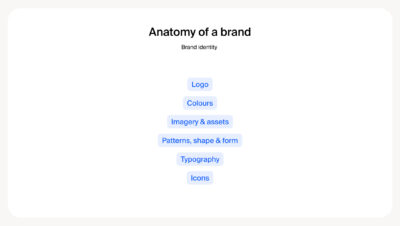
Give a Grad a Go
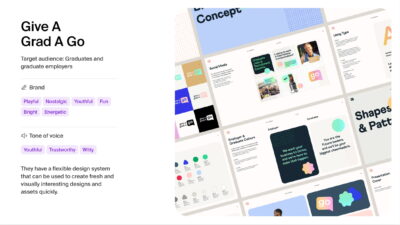
This is a client of ours and we worked with them on their logo and on their brand overall in terms of shape form colour, patternation, the way it all comes together, the lock ups between the photography, the illustration and how that’s held and used within their marketing devices. It’s fun and it’s bright and it’s nostalgic and it’s youthful. Now Give A Grad A Go, as you might expect, help hire graduates into client businesses. They bring together the right clients and the right candidates and to do that they need to attract the right candidates. Their brand is laser focused at the Graduate and the client also knows this – they see Give A Grad’s brand and website and can see why and how they have a great network of graduates and are best placed to deliver the best graduates to their clients.
Bond Global
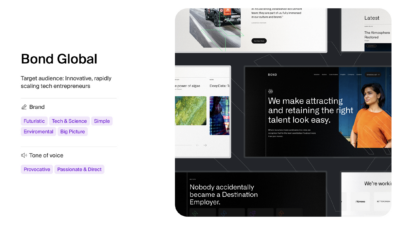
This is another client called Bond Global. They wanted to leave their print on the planet and again, needed bring together shape, form, colour and photography in just the right way. We collaborated with them not just in terms of just delivering a logo and a website and core branding and messaging, but how all of that comes together alongside the digital strategy as well. For me, this bringing together of shape, form and colour, and the interlock is a key element of brand that you can deliver against in order to create that feeling.
Noa
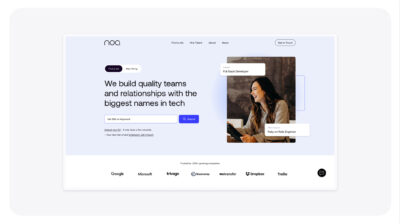
Noa is a small SME recruitment business that punch above their weight in the market. We collaborated to deliver a fantastic way of bringing together their brand which was simple but really well formed with a key colour scheme and with some layering techniques within their branding. So they get to use images to represent their clients and their candidates while interlaying them a way that gives them visual distinction for their target audience.
Why is brand important?
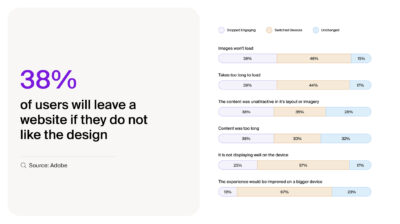
This statistic is from Adobe and highlights that 38% of people who land on your website will leave if they don’t like the look of it. So when you go to all this bother of targeting and positioning and messaging and imagery and so on, if it doesn’t look great and doesn’t align with your audience then they’ll leave. And actually the same is true for other factors such as challenges with the website images not loading or if the website isn’t very fast.
There’s lots of reasons why people might leave and so the quality of your digital footprint in terms of its speed and the way that it’s executed can make people feel that you’re established or good quality or capable or professional or any number of other things that you’re going to probably want to represent yourselves as online.
How to leverage brand
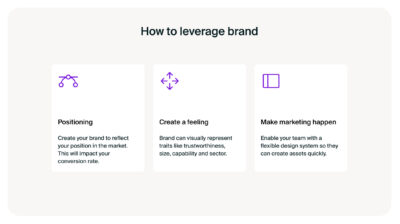
So when you’re thinking about leveraging a brand, I just want you to think about that position and understanding those quadrants and think about the attributes of those quadrants and how you’re going to align with them to create a feeling. We want to create that feeling of resonance.
Going back to that example that I used at the beginning about trying to find the right candidate for the right client – creating that feeling is super important and having the brand and the messaging nailed down and understanding your audience gives you such a great jumping off point to make marketing happen. You’re going to have that much better tool kit to get the stuff out the door and be much more effective in generating your awareness within the marketplace and generating those new clients that are the lifeblood of new business.
Being found by target personas
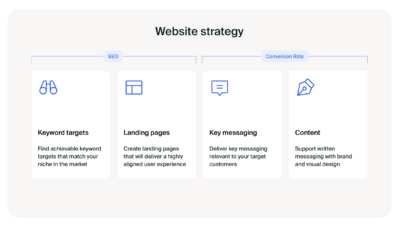
So you’ve got all this great marketing stuff. How are people going to find it? How are you going to get in front of them? Of course, in recruitment there’s a lot of outbound marketing that happens which is fantastic, but actually the agencies that do really well are also generating inbound client enquiries. This starts by understanding how those audience personas are going to find you and how and why they’re going to get in touch and convert into an inbound client lead.
This means you’re probably going to need a good website strategy because you need an effective way of ensuring that people find you and convert – and you need this even when you’re running outbound marketing by networking and using social media. Even if you’ve got someone you’ve worked with before and they’ve moved to a different business, if they say to the boss ‘hey we should use these guys for our recruitment because they’re really good’. The first thing their boss is going to do is Google you and check you out.
So how do we get the right people to find the right pages at the right time and turn into new leads? Your website strategy is re-divided into two key parts:
- There’s the SEO or the search engine optimisation
- There’s that keyword analysis which reviews keywords you’re going to target for success
And number 2 – that keyword analysis, is where we would love to go deep in terms of all those different attributes that we talked about with your target audience positioning. We create a barrel lock process to come up with hundreds of different keywords for location, sector, sub-sector, position type, position size, job role, job title. There’s a great number of things there that we’d love to get into those keywords to generate hundreds of keywords and then really slice those up into target landing pages where we get to resonate with those target audiences when people land. And that’s why the keyword alignment with the landing page alignment is so important. And for when they’re there, from a conversion rate perspective, those key messages are really going to create their resonance and drive new leads.
So website strategy is super important in terms of converting and not just from an SEO perspective, but whether it’s from LinkedIn, whether it’s from your outbound, whether it’s from offline referrals. The right people need the right places to send the right audiences to turn those into new leads.
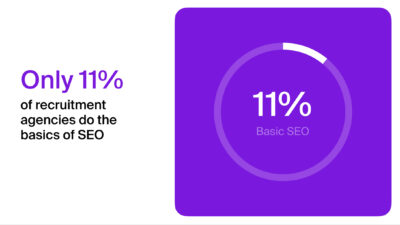
And it’s an amazing attribute of the recruitment marketplace that only 11% of recruitment agencies are doing the basics of SEO. And that really is the very basics of SEO and we’ve got a detailed report on the marketplace analysis of this as well that’s available on our website here and what we find is that actually just by exercising the ability to deliver the basics of SEO we can deliver huge outcomes for recruitment agencies.
Building keyword rankings
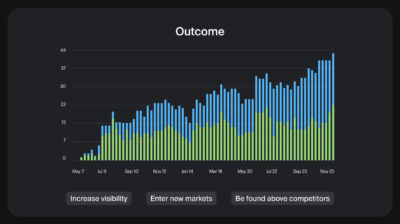
What we do at Plug & Play is once we’ve identified the market places and audiences, we go wide on keyword research, researching hundreds of keywords for each business. This chart is from an SEO management tool called Moz.com and each bar represents a week. The turquoise bars are the top three positions in Google and the green are the rest of page 1 of Google. What you can see here is that from launch through to when this was taken as a screen shot at just the end of November, you can see the enormous growth in rankings and market penetration.
The way we do that is we help businesses to identify the keywords that they have a statistical probability of succeeding in getting onto page 1. This approach makes sure you’re not going for keywords that you’ll never succeed in because the competition is too high. But also not going for so many keywords that you’re spreading resources to them lately. And also we want to target keywords with high intent so we’re confident that your target audience members are actually going to be Googling for or searching for them and are going to turn into visitors who are going to turn into leads into actual clients at the end of the day.
If you’re interested in finding out more about SEO, we have a talk available that takes a deep dive into how you can create and implement an SEO strategy.
Wrap up
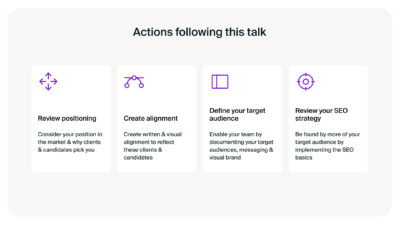
And so bringing all of this together creates that short list and that’s how we focus our customers energies efforts and budgets by using strategies that we have seen work elsewhere in similar scenarios to drive that growth and that performance outcome. And so SEO is a huge part of what we do is also a huge part of what recruiters could do if only you do the basics well.
I think what’s key for us today is the homework following this talk. I’d love you to review your positioning. I’d love you to think about those quadrants, those attributes and how you can demonstrate that you’re a leader within a niche or a sector by looking at creating those quadrants of those marketplace dynamics and understanding your positioning within them. That enables you to create alignment with your customers both in a written and a visual way. By defining your target audience from a personas perspective and from a business perspective you can create that resonance and that alignment in all of your marketing. And in doing so that means you can then generate keywords which means that you can target your SEO and get your website performance.
So that’s it. I’m in Peter Richman from Plug-and Play. We design and build websites. We do a great deal of work for recruiters from job portals and mobile apps to branding and marketing. We’ve got lots of great tools that you can use from our website so please download those. From here I hope your marketing improves and look forward to being to you soon.
If you would like a free consultation to discuss how you can implement a digital marketing strategy within your business, contact our team at [email protected] or call us on 0203 0111 641.


